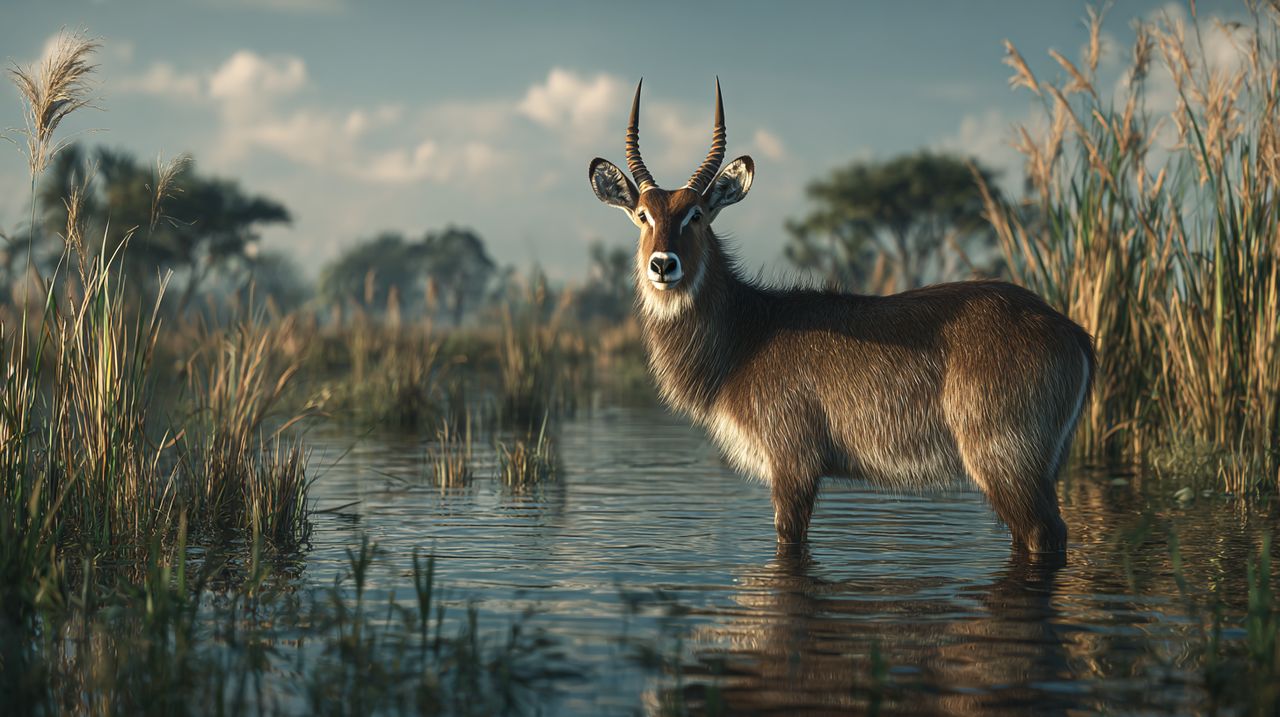The Water Goats Phenomenon: How Ungulates Conquer Aquatic Realms
The Concept of "Water Goats": Ungulate Adaptations to Aquatic Life
The term "Water Goats" might spark a vivid image in your mind – agile, resilient hoofed mammals gracefully moving through watery landscapes. While it’s not a formal scientific category, this concept beautifully captures a truly remarkable group of creatures.
These ungulates have developed truly extraordinary adaptations to thrive in semi-aquatic or fully aquatic environments. They challenge our usual ideas about their land-dwelling relatives, demonstrating an impressive capacity to flourish in diverse wetlands, expansive floodplains, and lush riparian zones.

[auras_task type=”research_topic” query=”Evolutionary adaptations of ungulates to aquatic environments” display=”explore-evolutionary-paths”]
Physiological Marvels: How "Water Goats" Thrive in Wet Habitats
To truly thrive in watery worlds, these animals undergo profound physiological transformations. For what we affectionately call ‘water goats,’ these adaptations are fascinating.
They include specialized hoof designs, unique fur characteristics, and even subtle adjustments to their breathing, each playing a vital role in their survival.
Unique Hoof Structures
Let’s begin with their unique hoof structures. Many of these ungulates feature elongated, splayed hooves. This distinctive shape is incredibly important, helping to distribute their weight evenly across soft, muddy terrain and preventing them from sinking.
Consider the sitatunga (Tragelaphus spekii), for instance. Its dramatically splayed hooves allow it to move with astonishing agility through dense papyrus swamps and deep marshlands – places where other large mammals would simply get stuck.
Water-Repellent Coats and Thermoregulation
Next, we observe their specialized coats, which often possess remarkable water-repellent qualities. The waterbuck (Kobus ellipsiprymnus) is a perfect example.
Its coarse, shaggy coat secretes a natural oily substance. This makes its fur largely impervious to water, a vital trait for keeping a stable body temperature even when frequently submerged.
Respiratory and Muscular Adaptations
Beyond hooves and coats, some "water goat" species show even more refined adaptations. Their musculature is specially adapted to power strong and efficient swimming strokes.
Interestingly, some species also get enough hydration directly from their water-rich diets, reducing their need for direct drinking.
[auras_task type=”scientific_study” query=”Sitatunga hoof morphology and locomotion” display=”research-sitatunga-adaptations”]
Behavioral Ingenuity: Navigating and Utilizing Aquatic Domains
Moving beyond their impressive physical traits, "water goats" also exhibit a sophisticated array of behavioral strategies. These tactics are crucial for them to effectively use aquatic resources and masterfully evade predators in their watery homes.
Specialized Foraging Strategies
Their foraging behaviors are meticulously tailored to their watery environments. These ungulates primarily consume:
- Aquatic vegetation
- Reeds
- Various grasses
This food source is usually out of reach for purely land-dwelling grazers. This specialized diet not only offers a unique nutritional source but also significantly reduces competition with other herbivores, effectively carving out a distinct ecological niche for them.
Water as a Critical Refuge and Evasion Tactic
Perhaps one of the most remarkable behavioral adaptations is their use of water as a critical refuge. When danger approaches, many "water goats" will submerge themselves, often leaving only their nostrils exposed above the surface. This allows them to effectively vanish from sight.
The sitatunga, in particular, can remain submerged for extended periods. Imagine its elongated neck stretching just enough to breathe – a truly incredible feat of evasion. This unparalleled ability to transform water into a defensive shield is a cornerstone of their survival, offering crucial protection from apex land predators such as:
- Lions
- Hyenas
- Wild dogs

Exemplary Aquatic Ungulates: Key Species Profiles
Now, let’s explore some specific species that beautifully embody the ‘water goat’ archetype. These examples showcase the incredible range of aquatic adaptations among ungulates.
They highlight diverse strategies for thriving in wetlands and floodplains.
The Waterbuck (Kobus genus)
The waterbuck (genus Kobus) is widely found across sub-Saharan Africa, inherently linked to aquatic environments. You’ll rarely find them far from water sources. They are powerful swimmers, often entering rivers and lakes to escape danger or to graze on lush aquatic vegetation.
Their most distinguishing feature is their oily, shaggy coat. This provides exceptional water resistance, allowing them to spend prolonged periods in wet conditions without ever becoming waterlogged.
The Elusive Sitatunga (Tragelaphus spekii)
Arguably the most specialized of the aquatic antelopes, the sitatunga (Tragelaphus spekii) is a true master of camouflage and evasion. It inhabits the dense swamps and marshes across central Africa.
Its remarkably long, splayed hooves are perfectly engineered for navigating treacherous, boggy terrain. Combined with its exceptionally secretive nature and unparalleled ability to submerge itself completely, the sitatunga remains one of the most elusive large mammals in its habitat.
[auras_task type=”ecosystem_role” query=”Sitatunga’s role in wetland ecosystems” display=”sitatunga-ecosystem-impact”]
The Red Lechwe (Kobus leche)
Found predominantly in the expansive floodplains and swamps of southern Africa, the red lechwe (Kobus leche) is a highly semi-aquatic antelope. You’ll often see these animals wading in water, and their populations show a profound connection to seasonal flooding cycles.
Red lechwe are excellent swimmers. They use their aquatic prowess to reach new foraging grounds and to evade predators, standing as a testament to ungulate adaptability in dynamic wetland environments.
Ecological Significance and Pressing Conservation Imperatives
The ‘water goats’ are far more than just fascinating examples of adaptation. They are integral components of their ecosystems, playing crucial roles that extend far beyond their individual survival.
Ecosystem Services and Biodiversity Contribution
By grazing on aquatic vegetation, these ungulates actively shape the landscape of wetlands. They influence critical processes like water flow and nutrient cycling. Their consistent presence supports a complex food web, providing a vital prey source for large carnivores and significantly contributing to the overall biodiversity and health of these unique habitats.
Major Conservation Challenges and Future Outlook
Despite their remarkable evolutionary adaptations, ‘water goats’ face significant conservation challenges. The main threat comes from habitat loss, driven by wetland drainage for agriculture, ongoing urban expansion, and widespread pollution.
Additionally, climate change introduces unpredictable variables. This leads to altered rainfall patterns and more frequent extreme events like droughts or floods, which severely impact their delicate ecosystems. Safeguarding the future of these extraordinary animals, and the invaluable ecological services they provide, requires focused conservation efforts.
These efforts must center on protecting and restoring wetlands. A comprehensive understanding of the intricate balance within these aquatic environments is absolutely paramount to ensuring the long-term survival of these specialized ungulates.
[auras_task type=”conservation_strategy” query=”Wetland conservation strategies for aquatic ungulates” display=”explore-conservation-solutions”]
💡 Frequently Asked Questions
"Water Goats" is a conceptual, non-formal term that refers to hoofed mammals which have developed extraordinary adaptations to thrive in semi-aquatic or fully aquatic environments, such as wetlands and floodplains.
Key adaptations include elongated, splayed hooves for distributing weight on soft, muddy terrain, water-repellent coats (often with oily secretions) for thermoregulation, and muscular adaptations that facilitate powerful swimming strokes.
Many "Water Goats" use water as a critical refuge by submerging themselves, often leaving only their nostrils exposed, to effectively vanish from sight and evade land-based predators. The sitatunga, for example, can remain submerged for extended periods.
The main conservation challenges are habitat loss, driven by wetland drainage for agriculture, urban expansion, and pollution, as well as the impacts of climate change, which leads to altered rainfall patterns and more frequent extreme weather events.





